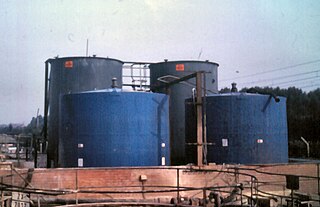
A filling station, also known as petrol station or gas station (US), is a facility that sells fuel and engine lubricants for motor vehicles. The most common fuels sold in the 2010s were gasoline and diesel fuel.

The flash point of a material is the "lowest liquid temperature at which, under certain standardized conditions, a liquid gives off vapours in a quantity such as to be capable of forming an ignitable vapour/air mixture".

Liquefied petroleum gas is a fuel gas which contains a flammable mixture of hydrocarbon gases, specifically propane and butane.

An underground storage tank (UST) is, according to United States federal regulations, a storage tank, including any underground piping connected to the tank, that has at least 10 percent of its volume underground.
The Todd Corporation is a large private New Zealand company with a value of $4.3 billion owned and controlled by the Todd family and is headquartered in Wellington, New Zealand. The corporation is currently led by chairman of the board, Henry Tait and Group Chief Executive Officer, Jon Young. And, the corporation currently employs 800 individuals across 20 locations in New Zealand, Australia and the United States. Which includes eight members employed to the Senior management team and nine individuals sitting on the Board of directors.

An oil terminal is an industrial facility for the storage of oil, petroleum and petrochemical products, and from which these products are transported to end users or other storage facilities. An oil terminal typically has a variety of above or below ground tankage; facilities for inter-tank transfer; pumping facilities; loading gantries for filling road tankers or barges; ship loading/unloading equipment at marine terminals; and pipeline connections.

Bunding, also called a bund wall, is a constructed retaining wall around storage "where potentially polluting substances are handled, processed or stored, for the purposes of containing any unintended escape of material from that area until such time as a remedial action can be taken."
The Energy Institute (EI) is a professional organization for engineers and other professionals in energy-related fields. The EI was formed in 2003 by the merger of the Institute of Petroleum and the Institute of Energy. It has an international membership of about 20,000 people and 200 companies. Its main office is at 61 New Cavendish Street, London. EI is a registered charity with a Royal Charter.

Naftna Industrija Srbije is a Serbian multinational oil and gas company with headquarters in NIS building, Novi Sad, Serbia. NIS is one of the most profitable companies in Serbia and one of the largest domestic exporters. It employs around 11,000 people in Serbia and the region. As of May 2022, Gazprom Neft is the largest shareholder with 50% of NIS shares, followed by 29.87% owned by the Government of Serbia, 5% owned by Gazprom and rest by minority shareholders.

Hindustan Petroleum Corporation Limited (HPCL) is an Indian oil and gas refining company headquartered in Mumbai. Since 2018, ONGC has owned a majority stake in the company. The company is ranked 367th on the Fortune Global 500 list of the world's biggest corporations as of 2016. On 24 October 2019, the company became a Maharatna PSU.
Subsea is fully submerged ocean equipment, operations or applications, especially when some distance offshore, in deep ocean waters, or on the seabed. The term is frequently used in connection with oceanography, marine or ocean engineering, ocean exploration, remotely operated vehicle (ROVs) autonomous underwater vehicles (AUVs), submarine communications or power cables, seafloor mineral mining, oil and gas, and offshore wind power.
The Petroleum Institute(PI) is a multidisciplinary research center of Khalifa University which focuses on oil, gas and broader energy industries. The Institute previously operated as an independent entity, funded by a consortium of national and international oil companies. The center is currently part of Khalifa University's Sas Al Nakhl Campus.

The Gubkin Russian State University of Oil and Gas is a public university in Moscow, Russia. The university was founded in 1930 and is named after the geologist Ivan Gubkin. The university is colloquially known as Kerosinka, meaning 'kerosene stove'.
The Oil Industry Safety Directorate (OISD) is a technical advisory body in India. It was established in 1986 by Ministry of Petroleum and Natural Gas. The OISD formulates and implements safety standards for the oil industry.

The oil and gas industry in New Zealand explores and develops oil and gas fields, and produces and distributes petroleum products and natural gas.
The petroleum industry in India dates back to 1889 when the first oil deposits in the country were discovered near the town of Digboi in the state of Assam. The natural gas industry in India began in the 1960s with the discovery of gas fields in Assam and Maharashtra. As on 31 March 2018, India had estimated crude oil reserves of 594.49 million metric tonnes (Mt) and natural gas reserves of 1339.57 billion cubic metres of natural gas (BCM).

The Energy Act 2016 is a UK Act of Parliament relating to UK enterprise law and energy in the UK. It created a new Oil and Gas Authority, meaning that a quango rather than a government minister deals with the oil and gas industry.

Sir Thomas Boverton Redwood FRSE FIC FCS FGS FRSA MIME (1846–1919) was a 19th-century British chemical engineer remembered as a pioneer of the petroleum industry. An early car-collector and enthusiast, he was also one of the first to investigate alcohol as a fuel.
ISO Technical Committee 67 – Oil and gas industries including lower carbon energy is a technical committee within the International Organization for Standardization (ISO). ISO/TC 67 is responsible for developing and maintaining international standards in the worldwide upstream, midstream and downstream oil and gas industry and related lower carbon energy activities. Its role encompasses the harmonisation of standards for facilities, equipment and operations used for drilling, production, pipeline transport and processing of liquids and gaseous hydrocarbons on, and between, offshore oil and gas installations and onshore terminals and oil refineries.











